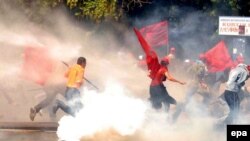Science fiction? Not entirely. All three are concepts for so-called nonlethal weapons considered by the U.S. Defense Department.
For years, the Pentagon has spent millions of dollars to develop a new generation of weapons it calls nonlethal or less lethal, to reduce casualties in war.
The bacterial cocktail and since-derided “gay spray” remained on the drawing boards.
But the ray gun was actually developed and this month, the Pentagon demonstrated it to journalists in the United States. Its name is Silent Guardian.”Developed by the Raytheon Corporation, the “gun” looks like a satellite dish.
Burning Sensation
It can be mounted on a truck and it works by firing off beams of high energy for up to 500 meters. Anyone in the path of the beams is zapped with an instant burning sensation that forces a retreat.
Physicist Juergen Altmann, of Germany’s Dortmund University, says the weapon works on a similar principle to microwave ovens.
"You know about microwave ovens. There, you use microwaves for heating," Altmann says. "This is a system where one uses so-called millimeter waves, where the wavelength is much shorter, so that the radiation penetrates into flesh and skin for a tenth of a millimeter -- 0.4 millimeters -- and heats only there, instead of being like a microwave oven, where [the waves] penetrate several centimeters."
The Pentagon, which demonstrated the system on journalist volunteers, says the Silent Guardian heats the flesh to 50 degrees Celsius -- just enough to cause pain, but not enough for any permanent damage.
But Altmann says that’s not entirely accurate.
"It only stays at 50 degrees Celsius if the beam is switched off at the correct time, let's say after 3.5 seconds," he says. "If you beam on for a further three or five seconds, then you get 60 and 70 and 80 degrees, and you get second- and third-degree burns on the whole part of the body that is exposed, because the beam is at least 3 meters wide, and probably a little wider. You get essentially half of the body exposed that is pointing toward the antenna. And then there is the potential for life-threatening conditions. Medical literature says that if you have somebody who has second- or third-degree burns on more than 20 percent of his body, then he has to be put into intensive care, because it's life-threatening."
Not So Harmless?
Press reports about the Silent Guardian make it sound at once powerful and harmless.
But Altmann says it’s important to remember that less lethal weapons are not all fun and games. It all depends what you do with them.
When it comes to biological and chemical weapons, international treaties place clear restrictions on their use. Even something as common as tear gas can only be used for domestic police operations, and not in war.
Altrmann says that’s because experience shows that in battle, nonlethal weapons are often used as precursors to deadly force.
"The Chemical Weapons Convention, for instance, bans the use of tear gas and similar things in armed conflict and war because the experience in Vietnam had been that U.S. forces drove Vietcong and Vietnamese civilians out of their tunnels with tear gas, and then just mowed them down with machine guns," he says.
For example, using the sedative Valium as an aerial dispersant -- another idea once considered by Pentagon researchers -- is currently illegal for just this reason.
But no international rules govern the use of electromagnetic weapons like the Silent Guardian.
That has scientists like Altmann concerned. He says there can be a legitimate use for weapons like ray guns -- but not on the battlefield and only under tight rules, by a police force subject to civilian, democratic control.
What happens if the highly mobile technology gets into the wrong hands? What if a repressive government chooses to zap human rights demonstrators for a few seconds longer than recommended? What happens if the ray gun is deployed on the battlefield, potentially scorching hundreds of combatants at one go? Would it still be considered nonlethal at that point?
There are no easy answers, but many experts hope for more discussion of such issues before these new technologies go into operation.







